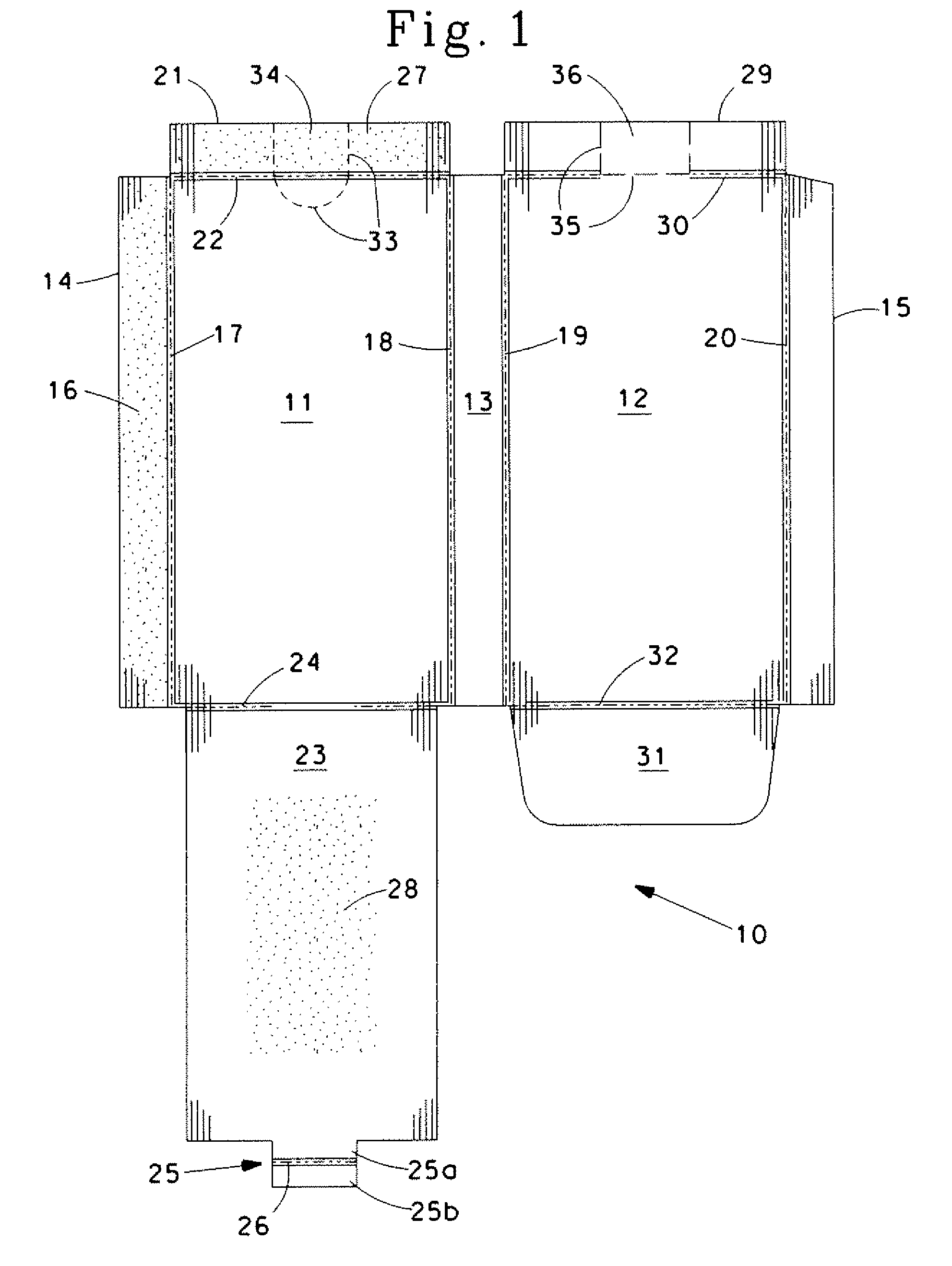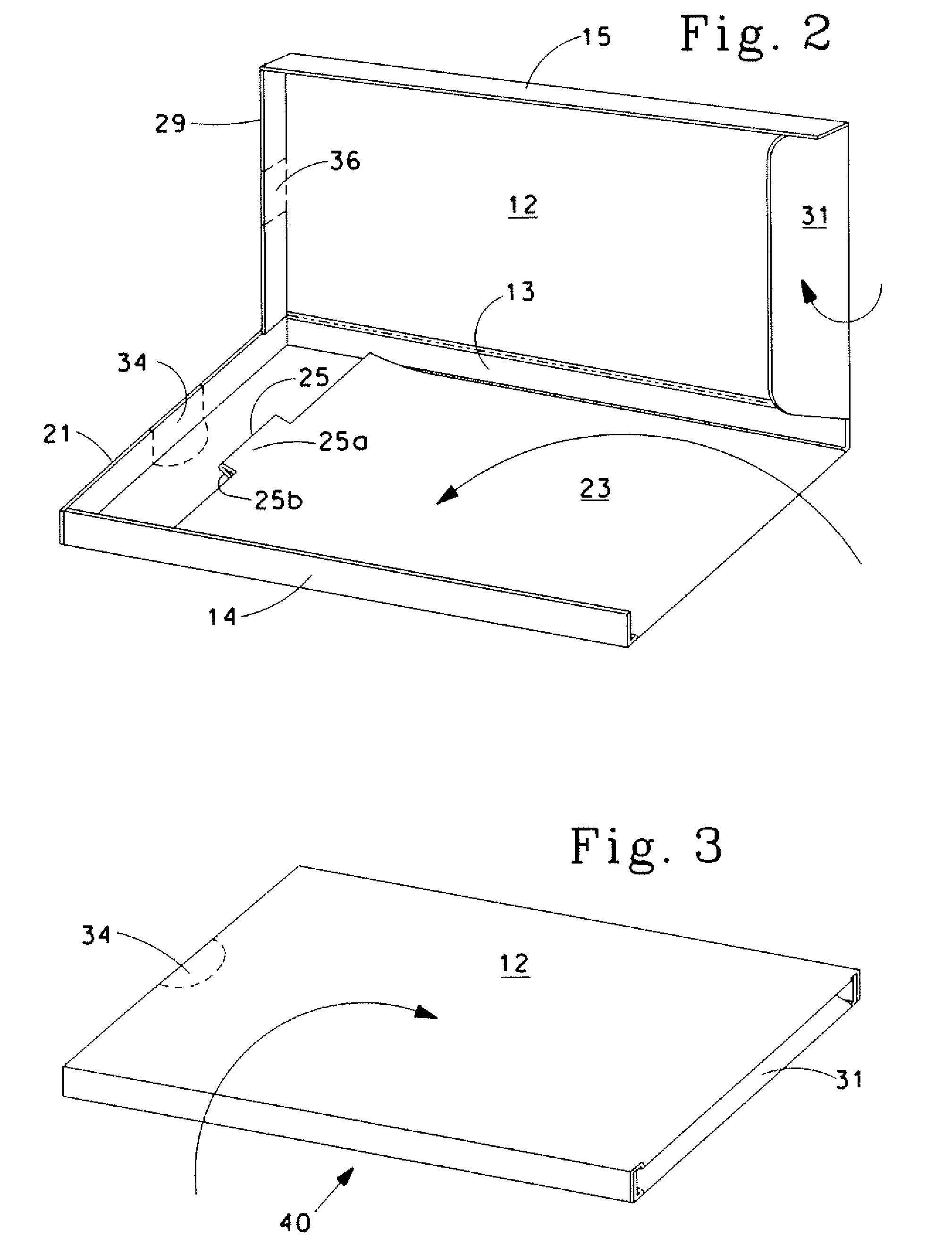Child-resistant package with latch and retaining feature
a latch and latch technology, applied in the field of child-resistant packaging, can solve the problems of difficult opening, difficult operation by a senior, and difficult opening for an adult, especially a senior, and achieve the effect of simple and inexpensive production, without adversely affecting the integrity of the packag
- Summary
- Abstract
- Description
- Claims
- Application Information
AI Technical Summary
Benefits of technology
Problems solved by technology
Method used
Image
Examples
first embodiment
[0085]A blank for making a first embodiment of sleeve for use in the package of the invention is indicated generally at 10 in FIG. 1. This view is looking at the surface of the blank that is the interior in a sleeve erected from the blank. The blank comprises two major panels 11 and 12 that form the top and bottom walls of a sleeve erected from the blank, a first minor panel 13 connected between adjacent side edges of the major panels and that forms one sidewall of a sleeve erected from the blank, and second and third minor panels 14 and 15 on opposite side edges of the respective major panels. Adhesive 16 is applied to the surface of at least one of the minor panels 14 or 15 (shown applied to the panel 14 in the example illustrated), and in a sleeve erected from the blank the panels 14 and 15 are overlapped and glued together to form a second sidewall of the sleeve. The minor panels are joined to the major panels along parallel creased fold lines 17, 18, 19 and 20.
[0086]A first fla...
second embodiment
[0102]A blank 80 for making a second embodiment of sleeve according to the invention is shown in FIG. 14. As in the first embodiment, the blank comprises two major panels 81 and 82 that form the top and bottom walls, respectively, of a sleeve erected from the blank, and a first minor panel 83 connected between adjacent side edges of the major panels along fold creases 84 and 85 to form one sidewall of a sleeve erected from the blank. End flaps 86 and 87 are foldably joined to adjacent ends of respective major panels 81 and 82 along fold creases 88 and 89, respectively, and in a sleeve erected from the blank these flaps are overlapped and glued together to form an end wall. Lines of perforations 90 and 91 in these flaps define tear out panels 92 and 93, and an extension panel 94 is foldably joined to the end of panel 82 along fold crease 95, all as in the previous embodiment.
[0103]This second embodiment of the invention differs from the previous embodiment in that there is no minor p...
third embodiment
[0106]A blank 110 for making a third embodiment of sleeve according to the invention is shown in FIG. 18, which is an outside view of the blank. This embodiment closely resembles the first embodiment, and the same reference characters, primed, are used in this figure to describe corresponding parts to those in the first embodiment shown in FIG. 1. Thus, the blank 110 comprises two major panels 11′ and 12′ that form the top and bottom walls of a sleeve erected from the blank, a first minor panel 13′ connected between adjacent side edges of the major panels and that forms one sidewall of a sleeve erected from the blank, and second and third minor panels 14′ and 15′ on opposite side edges of the respective major panels. Adhesive 16′ is applied to the surface of one of the minor panels 14′ or 15′ (shown applied to the panel 14′ in this embodiment), and in a sleeve erected from the blank the panels 14′ and 15′ are overlapped and glued together to form a second sidewall of the sleeve. The...
PUM
 Login to View More
Login to View More Abstract
Description
Claims
Application Information
 Login to View More
Login to View More - R&D
- Intellectual Property
- Life Sciences
- Materials
- Tech Scout
- Unparalleled Data Quality
- Higher Quality Content
- 60% Fewer Hallucinations
Browse by: Latest US Patents, China's latest patents, Technical Efficacy Thesaurus, Application Domain, Technology Topic, Popular Technical Reports.
© 2025 PatSnap. All rights reserved.Legal|Privacy policy|Modern Slavery Act Transparency Statement|Sitemap|About US| Contact US: help@patsnap.com



